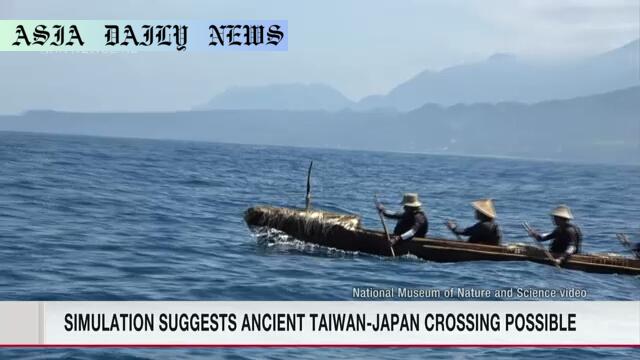Kuroshio Current: Research shows ancient humans crossed Taiwan-to-Okinawa waters 30,000 years ago using canoes.
- Supercomputer simulation reveals insights into ancient crossings of Taiwan-to-Okinawa waters using canoes 30,000 years ago.
- Findings show ancient humans strategically navigated adverse Kuroshio currents with calculated risks and remarkable resourcefulness.
- Research validates earlier experiments conducted in 2019 by Japanese scientists using a dugout canoe, successfully reaching Yonaguni Island.
- Published in Science Advances, study highlights similarities between ancient and modern human risk-taking.

Introduction: The Kuroshio Current and Ancient Navigation
The mystery of ancient human migrations has long fascinated researchers and anthropologists alike. A recent study conducted by an international team of scientists led by experts from Japan delves deeper into one such migration that occurred over 30,000 years ago. By studying the Kuroshio Current, one of the world’s strongest ocean currents, researchers aimed to understand how early humans might have successfully navigated this formidable natural barrier using rudimentary tools and vessels. Groundbreaking results have been published in the prestigious U.S. journal Science Advances, shedding light on ancient ingenuity and survival tactics.
Simulation: Recreating a Journey Through Time
To further validate the hypothesis, researchers employed a supercomputer to simulate conditions that potentially existed 30,000 years ago. Led by Deputy Senior Scientist Yu-Lin Chang of JAMSTEC and Professor Kaifu Yosuke of the University of Tokyo, the team recreated sea currents from the era by integrating historical climate data into numerical models. This state-of-the-art simulation examined conditions that might have allowed an ancient dugout canoe to traverse the 110-kilometer strait between Taiwan and Japan’s southwestern Yonaguni Island, even with the Kuroshio Current flowing 10% faster than today.
The simulation built upon lessons learned from a 2019 experimental voyage. During this trial, researchers constructed a dugout canoe and successfully navigated from Taiwan to Yonaguni. Assuming an ancient canoe could achieve a speed of 1.08 meters per second, the simulation suggested that strategic adjustments—departing from northern Taiwan and paddling in a southeastern direction against the current—would allow early navigators to cross this challenging stretch of water successfully.
Human Ingenuity: Strategic Risk-Taking
This study highlights the exceptional skills and foresight of ancient humans. The findings underscore the strategic thinking required to undertake such treacherous journeys. Professor Kaifu remarked how these early explorers must have been acutely aware of the risks involved, yet their confidence and determination led them to push boundaries. In essence, their capability to assess and mitigate danger mirrors aspects of modern human behavior.
Interestingly, the research frames these early navigators as bold pioneers who demonstrated an intricate understanding of natural forces. Their ability to plan expeditions, prepare for adversities, and overcome environmental challenges reflects traits deeply ingrained in human evolution.
Broader Implications of the Study
The study provides compelling insights into how ancient humans migrated across regions and possibly communicated between distant civilizations. Such findings emphasize the significance of maritime knowledge in shaping early societal networks. With advanced technology such as supercomputers, researchers can continue exploring historical enigmas, bridging gaps in our understanding of human history.
The discovery also invites a broader discourse on current technological advancements versus ancient ingenuity. Despite lacking modern tools, early humans expertly utilized their available resources, conveying humanity’s enduring capacity for innovation and resilience.
Conclusion: Bridging the Past and Present
As our understanding of ancient migrations improves, so too does our appreciation for the ingenuity of our ancestors. The successful simulation of a 30,000-year-old voyage against the Kuroshio Current provides a vivid testament to the intelligence and determination of early humans. This study is not just about where humans migrated but also about how they overcame insurmountable odds to expand their horizons.
The findings continue to inspire conversations about humanity’s shared past, serving as a reminder of the traits that unite ancient and modern civilizations: curiosity, courage, and an unwavering drive to explore.



Commentary
The Timeless Human Spirit of Exploration
The study on ancient humans crossing the Taiwan-to-Okinawa waters presents a fascinating glimpse into the resilience and brilliance of our ancestors. It is truly amazing to consider how humans, 30,000 years ago, navigated through treacherous waters, particularly against one of the world’s most robust ocean currents, the Kuroshio Current. This demonstrates not only their survival instinct but also their ability to think strategically and innovate in the face of danger.
Reflection on Ancient Ingenuity
What stands out to me is how this research parallels traits in modern-day individuals. The ancient voyagers must have possessed exceptional determination, thorough planning skills, and situational awareness, qualities that are often celebrated in contemporary pioneers and innovators. Their decision to take on such an arduous journey reveals a confidence in their preparation and capabilities, and their success signifies intelligence and teamwork—hallmarks of human evolution.
The Broader Relevance of the Study
Moreover, this study serves as a bridge between history and the present. It compels us to question what drives humanity toward exploration. Whether it is traversing oceans thousands of years ago or exploring space today, the underlying human trait remains the same: an innate curiosity and the courage to venture into the unknown. With advanced technology like supercomputers helping us unravel these ancient mysteries, it’s thrilling to imagine the uncovering of more stories that connect us to our distant ancestors.
Inspiration for the Present and Future
The study is a powerful reminder of the ingenuity of humans throughout time. More so, it invites us to reflect on our shared history and reminds us that the qualities exhibited by early humans—adaptability, courage, and strategic thinking—continue to define humanity today. These findings are a testament to our enduring capacity to not only survive but thrive in the most challenging circumstances.